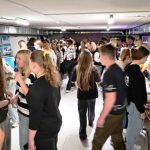 As you know, the International Day of Light is a holiday celebrated since November 14, 2017 at the initiative of UNESCO. It not only emphasizes the importance of light in our lives, but also commemorates the anniversary of the successful testing of the laser, which was carried out on May 16, 1960, by its inventor, the american physicist and engineer Theodore Maiman.
As you know, the International Day of Light is a holiday celebrated since November 14, 2017 at the initiative of UNESCO. It not only emphasizes the importance of light in our lives, but also commemorates the anniversary of the successful testing of the laser, which was carried out on May 16, 1960, by its inventor, the american physicist and engineer Theodore Maiman.
This year, the holiday was organized by the Central Admissions Committee of NTU “KhPI” on May 16 at the Kharkiv scientific lyceum “Genius”. Like the previous non-distance career guidance event, which was held almost a month ago, this one was also held in a bomb shelter, which ensured complete safety of all participants in conditions of air raids in front-line Kharkiv.
It is quite natural that the Department of Occupational and Environmental Safety could not fail to participate in this event. For this purpose, scientific and pedagogical workers prepared career guidance posters and campaign brochures, and for a visual demonstration – devices for monitoring dangerous and harmful production factors: Mestek IR01C pyrometer; digital vane anemometer VTMETER VT-816V, Robotron RTF 00024 sound level meter, Yu-116 lux meter, and GM3120 electromagnetic radiation tester.
Associate professor Eugene Yascheritsyn directly participated in the career guidance event, who during the event told the students about the prospects of the specialty J4 “Occupational health and safety” and educational program “Occupational health and safety”, the possibility of internships, training and obtaining a double diploma at foreign universities. Employment prospects and positions that young specialists in this field will occupy after training were also discussed.
Naturally, the students of the scientific lyceum were interested in the possibility of working with devices for controlling dangerous and harmful production factors.
Using the example of a bomb shelter in which this event was held, assoc. prof. Eugene Yascheritsyn demonstrated the determination of parameters of dangerous and harmful factors, such as: noise level indicator – 58…74 dBA, illumination level at different points – 200…8500 lux, electric field strength 0…102 V/m; magnetic induction – 0…16.6 μT; air temperature in the bomb shelter, which during the event ranged from 20 to 23 °C, humidity – 45 %, air speed less than 0.1 m/s.
In general, it should be noted that the maximum values of magnetic induction (about 16 μT) and electric field (about 102 V/m) were recorded directly on the housings of electrical equipment used during the event. As the GM3120 device moved away from this equipment, the values of the levels of these factors decreased to zero. Therefore, it should be noted that the levels of harmful and dangerous production factors measured in the bomb shelter fully satisfied the conditions for holding the event.
The career guidance work of the department’s teachers continues!
Associate professor of the department «OandES» Eugene Yascheritsin






